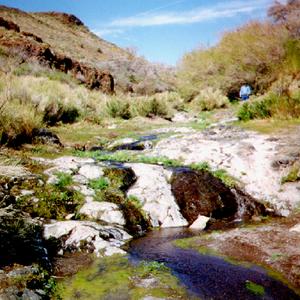|
Our
African American Heritage - Wagon Road West "Revisited"

Written and submitted by James Russell
Barnes
I submitted an article to the Tazewell County Historical Society for
publication in September 1995 called "Wagon Road West". The article
involved two individuals from Tazewell County who participated in the
survey and construction of a U.S. wagon road sponsored by the War
Department. This road would extend from Ft. Smith, Arkansas to the
Colorado River on the Arizona and California borders.
This monumental task was accomplished under the leadership of Edward
Fitzgerald Beale, noted explorer of the southwestern territories. The
participants from Tazewell were; Dr. William P. Floyd, who served as
camp physician and William Johnston Warren (my wife’s great-great
grandfather). It has not been determined in what capacity he served on
this trip. Johnston was a tanner by trade and could have possibly taken
care of the leather goods for the horses and the many mules involved.
The group departed Ft. Smith, Arkansas in the fall of 1858 and arrived
at the Colorado River, in California the following summer. During this
time, they endured the hardships of extreme weather conditions, hostile
indigenous people and a harsh unforgiving land.
As I noted in my last article, the purpose of my research was to verify
the existence of a "Johnston’s Canyon" that was supposedly named after
Johnston Warren.
I examined many maps of the area, read several personal journals and
books with descriptions of the journey but, much to my dismay, was never
able to ascertain the location of "Johnston’s Canyon".
Enter 20th century technology. While surfing the internet for
information on Beale, I found the web page of the University of
Northern Arizona. They had a collection of information in their library
concerning Beale. It was also noted that in 1974, a graduate student
named Jack Smith wrote about the Beale Wagon Roads as his thesis.
I was fortunate enough to talk to and correspond with Jack Beale Smith
(distantly related to E. F. Beale). He is a very knowledgeable
historian who has written several books and pamphlets for the Arizona
State Parks service. He and his associates were delighted with the
additional information that I provided to them. They are
preservationist of the Beale
Wagon Road and the old Route 66, which generally follows the old wagon
road.
I received a call from Jack who had delightful news. He found
“Johnston’s Canyon”. It is located on what is now a dairy farm near the
town of Kingman, Arizona. The local populace has been referring to the
area as “Johnson” canyon because the owner of the property is named
Johnson. They have owned the land since the 1880’s. The owner told
Jack that during his childhood, he remembers seeing a rock inscribed
with “Johnston” carved in it but thought that it was just a misspelling
of Johnson. Further investigation shows that U.S. Government
topographical maps indicate the name “Johnston” as the proper name.
Jack and some of his fellow historians took a trip up to the site and
searched for the rock formation with the inscription. They were unable
to find it and surmised that it has been obliterated when a modern
pipeline was constructed across the canyon in the 1950’s. even without
this definitive proof, Jack feels absolutely confident that this is the
correct location of the canyon . Maps of the period and first hand
journals of the participants indicate that Beale and his party camped at
that area on July 4, 1859.
Photos indicated that the area was extremely rocky and barren and the
"canyon" looks as if it is a dip in the surrounding terrain with a flow
of water coming forth from it. Jack explained that, early on, this was a
major source of water for the town of Kingman.
Jack Smith and his organization have discussed placing a brass
historical marker at the site to commemorate the events.
The marker would read:
|
WILLIAM JOHNSTON WARREN
"Water 1/4 mile above"
Born a slave in Virginia in 1808, Purchased his freedom in 1858. Joined Lt. Beale’s road building party in 1858. Found Johnston’s Springs on July 4, 1859. Beale named the spring and canyon after him on July 4, 1859. |
Photograph of water running over the rocks looking up the
canyon towards the source of Johnston Spring.
Originally published in the March 1999 issue
of the Tazewell County Historical Society Newsletter
Source of information: Welcome To The Beale Wagon Road, by Jack B.
Smith.:
Published by: Kingman Parks and
Recreation Department.
Mr. Jack Beale Smith
P.O. Box 31391:
Flagstaff, Arizona 86003
Note: Mr. Smith is a great source
of information concerning
early Americana in
general. He has studied wagon train,
native American history:
and is currently exploring railroad
construction campsites.
Submitted by: James Russell Barnes,
Atlanta, Georgia
|